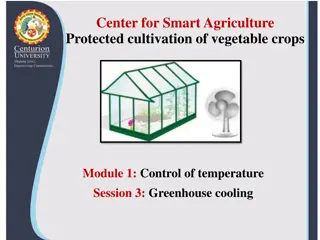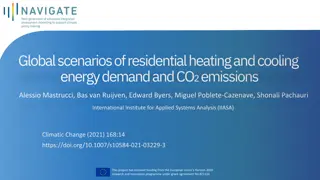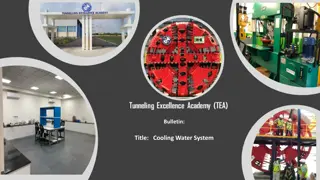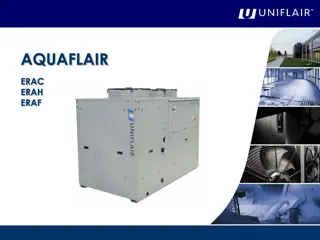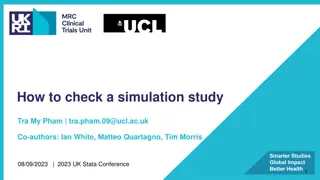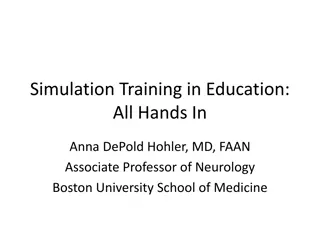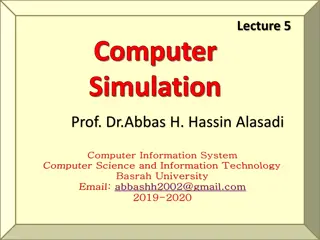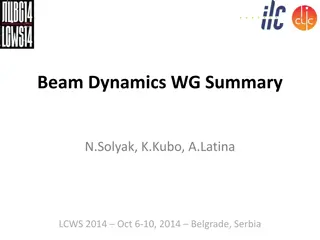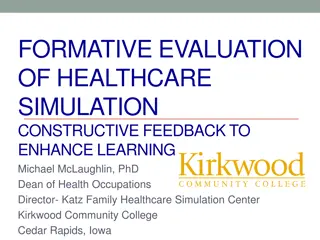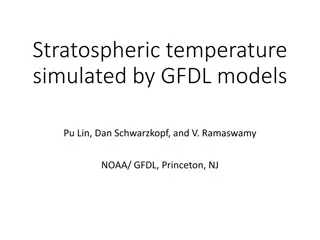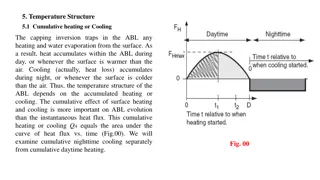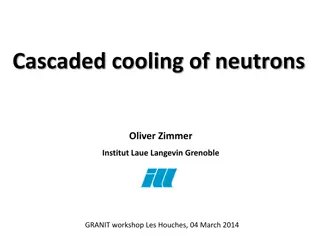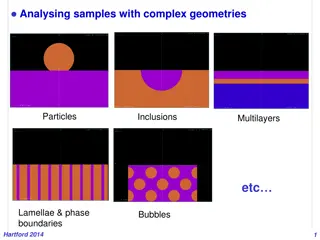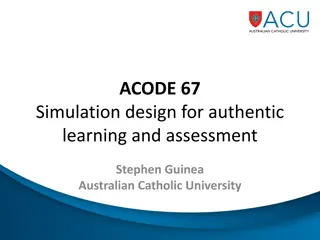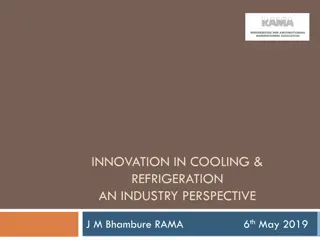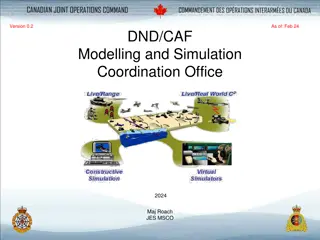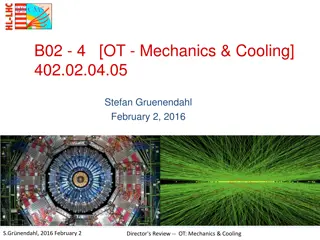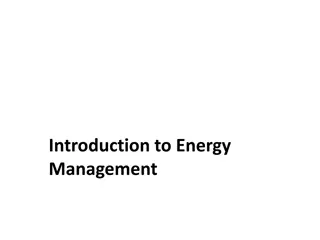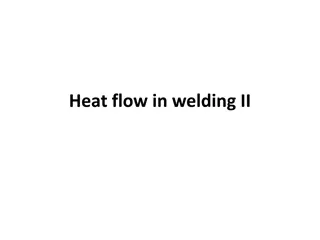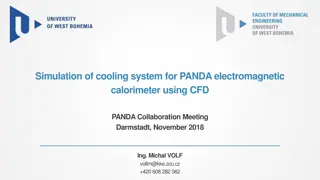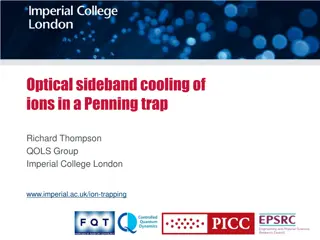Protocol: Cooling Basics, Clinical Considerations, and Phases of Care
The essentials of cooling protocols and clinical considerations, focusing on temperature management, thermoregulation basics, effects of hypothermia/cooling, central temperature measurement, and factors influencing target temperature. It emphasizes the importance of safe monitoring and application o
2 views • 72 slides
System Modeling and Simulation Course Overview
This course covers the basics of systems modeling, discrete-event simulation, and computer systems performance evaluation. Topics include Monte Carlo simulation, probability models, simulation output analysis, queueing theory, and more. Professor Carey Williamson leads the course with a focus on pra
4 views • 21 slides
Cryogenic Sub-systems
Explore the relationship between liquefaction, refrigeration, and isothermal processes in accelerator systems. Understand the equivalent exergy in Watts for different gases at 1 bar and 300K. Calculate the reversible input power required for latent cooling and the total cooling in different scenario
1 views • 9 slides
Coolclean Cooling Tower Service Benefits
Coolclean carry out comprehensive cooling tower servicing to not just clean, but to also ensure that the cooling tower cools to its maximin efficiency, to reduce water and chemical usage, to reduce electrical power consumption, to reduce environmental damage, to control bacteria growth, and comply w
1 views • 3 slides
Advanced Microbunched Electron Cooling for EIC Design Overview
Microbunched electron cooling is a cutting-edge technique proposed for the Electron-Ion Collider (EIC) design, aimed at enhancing beam properties through coherent electron interactions. The concept utilizes Coherent Electron Cooling (CeC) and broad-band amplification in the form of Micro-bunched Ele
1 views • 16 slides
Advanced Cooling Solutions for Immersion Servers by Asperitas
Asperitas offers an innovative immersion cooling solution for servers, featuring the AIC24-15/19/21 technology with advanced power and compute densities. The integration solution includes power delivery, management, cooling, monitoring, and containment features for optimal performance. Their Shell I
1 views • 19 slides
Overview of Army Modeling and Simulation Office
The U.S. Army Modeling and Simulation Office (AMSO) serves as the lead activity in developing strategy and policy for the Army Modeling and Simulation Enterprise. It focuses on effective governance, resource management, coordination across various community areas, and training the Army Analysis, Mod
1 views • 8 slides
Understanding Engine Cooling Systems
The cooling system in an engine is vital for maintaining optimal operating temperatures, preventing overheating, and ensuring efficient combustion. There are different types of cooling systems such as air cooling and liquid cooling, each with its advantages and disadvantages. Air-cooled engines rely
0 views • 23 slides
Efficient Greenhouse Cooling Systems for Smart Agriculture
Active summer cooling systems like fan-and-pad and fog systems are crucial for maintaining optimal temperatures in greenhouses. These systems work by utilizing evaporation to remove heat from the air. Fan-and-pad cooling systems have been in use since 1954, where water is passed through pads to cool
1 views • 23 slides
Global Scenarios of Residential Heating and Cooling Energy Demand
This study presents global scenarios of residential heating and cooling energy demand and CO2 emissions, focusing on the evolution of building stock, energy demand, and emissions for space heating and cooling. The research aims to address the limitations in current global scenario studies by develop
8 views • 5 slides
Cooling Water Systems in Construction: Overview and Risk Management
Understanding the operation of cooling water systems in construction, specifically focusing on cooling towers and their usage in Tunnel Boring Machines (TBMs). Importance of proper maintenance to prevent the growth of Legionella bacteria and mitigate the risk of Legionnaires' disease. The process of
0 views • 6 slides
Overview of Aquaflair and Uniflair Chillers
The AquaflairERACERAHERAF1 series features state-of-the-art technology for maximum reliability and efficiency. With cooling capacities ranging from 50 to 110 kW, these chillers utilize environmentally friendly R410A refrigerant and electronic thermostatic valves for energy efficiency. The ERAC, ERAH
0 views • 96 slides
How to Check a Simulation Study: Methods and Considerations
Simulation studies are often used to evaluate statistical methods and study power, but they can sometimes produce misleading results. This work discusses strategies to assess and improve the quality of simulation studies, drawing on experiences and considerations outlined in relevant literature. A s
0 views • 31 slides
District Cooling Trends and Companies in Finland
Explore the latest developments in district cooling in Finland, including the increase in connected load and energy production capacity. Discover how energy companies are contributing to the growth of district cooling services. Learn about the innovative production methods and energy sources utilize
0 views • 8 slides
System Modeling and Simulation Overview
This content provides insights into CPSC 531: System Modeling and Simulation course, covering topics such as performance evaluation, simulation modeling, and terminology in system modeling. It emphasizes the importance of developing simulation programs, advantages of simulation, and key concepts lik
0 views • 28 slides
Basin Manipulation Simulation Analysis Tool Overview
Basin Manipulation Simulation Analysis Tool provides a comprehensive solution for managing and analyzing basin data, including tasks like basin manipulation, simulation analysis, case management, and defining simulation time steps. The tool allows for easy data entry, visualization of simulation res
2 views • 17 slides
Simulation Training in Education: Enhancing Learning Through Hands-On Simulation
Hands-on simulation training in education provides students with valuable learning experiences by increasing self-reported knowledge and technical proficiency. Simulations help improve students' knowledge, experience, and comfort with challenging procedures in a lower-risk environment, leading to en
0 views • 13 slides
Understanding Computer Simulation and Modeling Tools
Computer simulation and modeling is essential for conducting studies in various fields. Selecting the right simulation language or package is crucial for accurate results. This involves considering the characteristics of the language, such as random number generation, process transformers, list proc
0 views • 7 slides
LED Bulb Cooling Simulation with COMSOL
LED bulbs are preferred for their longevity and energy efficiency, but 70% of electrical power is lost as heat. This simulation using COMSOL optimizes the design to prevent overheating by considering heat sources, heat transfer, natural convection, and boundary conditions. Results show efficient coo
0 views • 7 slides
Advanced Beam Dynamics and Machine Protection in High-Energy Linacs
Overview of recent talks and discussions at LCWS 2014 in Belgrade, Serbia, focusing on machine protection, simulation codes, instrumentation, and system tests. Topics include beam-loss monitors, dark current measurements, simulation code developments, and beam dynamics studies in linacs. Key speaker
0 views • 12 slides
Enhancing Healthcare Simulation Through Constructive Feedback
Explore the principles and benefits of healthcare simulation, focusing on formative evaluation and constructive feedback to improve learning outcomes. Delve into the role of formative assessment tools, TeamSTEPPS model, and Mayo High Performance Teamwork Scale in simulation scenarios. Discover the s
0 views • 37 slides
Simulation of Stratospheric Temperature by GFDL Models: Observations and Trends
Interannual variations of stratospheric temperature since 1979 are well simulated by GFDL models, showing general cooling trends, stronger cooling over Southern Hemisphere high latitudes, post-eruption warming, delayed cooling after eruptions, and flat trends in the 2000s. However, models tend to ov
0 views • 10 slides
Understanding Temperature Structure and Cumulative Heating/Cooling in Atmospheric Boundary Layer
The temperature structure in the atmospheric boundary layer (ABL) is influenced by cumulative heating or cooling effects from the surface. During the day, heat accumulates within the ABL, while cooling occurs at night. The cumulative heating or cooling is more crucial for ABL evolution than instanta
0 views • 12 slides
Beam Polarization Simulation Study for CEPC
Simulation study on beam polarization for the Circular Electron Positron Collider (CEPC) using the PTC Poly- morphic Tracking Code. The study includes orbital and spin tracking, equilibrium polarization calculation, and Monte-Carlo simulation of depolarization rate. Comparison with other Monte-Carlo
0 views • 20 slides
Advanced Cooling Solutions: ACS Cold Plate Focus Areas
Introduction to ACS Cold Plate focus areas led by Jessica Gullbrand from Intel. The objective is to standardize liquid-cooled solutions without hindering innovation. The ongoing focus includes approval of cold plate requirements, initiation of Open Rack V3 Blind Mate Liquid Cooling, and various work
0 views • 20 slides
Cooling Strategies for Low-Income Customers in California
Learn about PG&E's initiatives to provide cooling strategies for low-income customers, including CARE funds for Cooling Centers and ESA-provided Cooling Measures. Regulatory guidance ensures long-term energy consumption reductions without burdening low-income ratepayers. Find out what Cooling Center
0 views • 12 slides
Introduction to VLSI CAD and Discrete-Event Simulation at Tufts University
This course introduces students to event-oriented simulation, building virtual models, and validating designs through simulation. It covers the importance of simulation in testing and refining designs before implementation. Examples include simulating VLSI networks and exploring the use of discrete-
0 views • 32 slides
Advancements in Neutron Cooling Techniques and Paramagnetic Systems
The presentation discusses cascaded cooling of neutrons and Namiot's proposal for phononless cooling to low temperatures using polarized deuterons. It explores inelastic scattering cross-sections, candidate paramagnetic systems, and excitations in O2. Additionally, it covers rate constants, superflu
0 views • 11 slides
Advanced Simulation Techniques for Analyzing Samples with Complex Geometries
Explore the capabilities of PENELOPE simulation software for analyzing samples with intricate structures like particles, inclusions, multilayers, lamellae, and phase boundaries. The software facilitates detailed investigations of material composition and electron-photon transport in diverse geometri
0 views • 28 slides
Simulation Design for Authentic Learning and Assessment at ACU
Simulation design for authentic learning and assessment is a crucial aspect of education, particularly in the healthcare field. At the Australian Catholic University (ACU), simulation plays a significant role in providing students with authentic experiences that bridge the gap between theory and pra
0 views • 18 slides
Innovation in Cooling & Refrigeration: Industry Challenges and Opportunities
This presentation explores the current state of cooling and refrigeration in India, highlighting the significance of innovative technologies in addressing the growing demand for efficient cooling solutions. The discussion includes insights on India's climate zones, cooling needs, refrigeration deman
0 views • 13 slides
The Right Way to Code Simulation Studies in Stata
Simulation studies in Stata involve using (pseudo) random numbers to generate data from a distribution for studying statistical methods. This process helps to evaluate different scenarios and understand the properties of statistical techniques. Key components like ADEMP (Aims, Data-generating mechan
1 views • 18 slides
Simulation Results for LC-Optimized PHY Proposal in July 2019
The document presents simulation results for an LC-optimized PHY proposal for TGbb based on G.9991 PHY. It includes details on the simulation setup, frame detection results, header modulation, coding simulation results, payload modulation, and coding simulation results. The setup involved various re
0 views • 18 slides
Thermoelectric Module with PID Control Simulation
This simulation showcases a lumped thermoelectric module with PID control. The model evaluates the performance of a thermoelectric element in a nonisothermal fluid flow around a heat sink. A stationary simulation assesses the module's capabilities, followed by a transient simulation with a PID contr
0 views • 7 slides
Defense Modeling and Simulation Coordination Office Overview
The Defense Modeling and Simulation Coordination Office (DND/CAF MSCO) is responsible for managing contractors, policies, and strategic activities related to modeling and simulation within the Canadian Armed Forces. The office focuses on supporting various organizations and enhancing capabilities th
0 views • 6 slides
Director's Review - Mechanics & Cooling Overview
The US will design and build the central portion of the Phase 2 Tracker Barrel Pixel Strip Detector (TBPS), focusing on mechanics and cooling. The project involves three layers of PS modules with specific lengths, utilizing carbon fiber/carbon foam sandwich planks with embedded CO2 cooling. Collabor
0 views • 19 slides
Understanding Evaporative Cooling and Cooling Towers in Energy Management
Dive into the world of evaporative cooling and cooling towers with this detailed chapter. Learn about direct and indirect cooling processes, psychrometric phenomena, range and approach in cooling systems, different airflow arrangements in cooling towers, and the theory behind evaporative cooling. Di
0 views • 20 slides
Welding Heat Flow and Cooling Rate Calculations
Understanding welding heat flow and cooling rate calculations is essential for determining the critical cooling rate in welding processes. Factors such as plate thickness, number of passes, and relative plate thickness play a crucial role in selecting the appropriate equations for calculating coolin
0 views • 10 slides
Simulation of Cooling System for PANDA Electromagnetic Calorimeter
A detailed study on optimizing cooling system design for the PANDA electromagnetic calorimeter using Computational Fluid Dynamics (CFD) to enhance temperature stability and light yield efficiency. The simulation focuses on factors like cooling tube arrangement, mass flow rate, and fluid properties i
0 views • 11 slides
Optical Sideband Cooling of Ions in a Penning Trap - Research Summary
Researchers at Imperial College London, led by Richard Thompson, have made significant contributions in the field of optical sideband cooling of ions in a Penning trap. This technique involves laser cooling in the trap, large Lamb-Dicke parameters, sideband cooling of ions, coherent manipulation of
1 views • 34 slides








